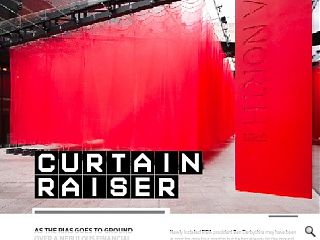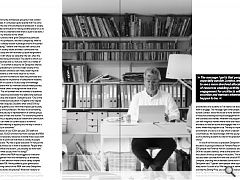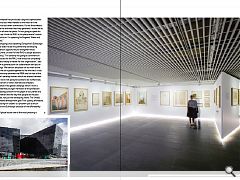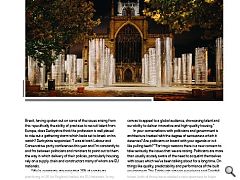RIBA: Curtain Raiser
25 Jan 2018
As the RIAS goes to ground over a nebulous financial scandal which threatens to engulf it Urban Realm catches up with Ben Derbyshire, newly installed head of its bigger brother down south, to see how he aims to bring effective leadership to a rudderless profession at a time of national upheaval.
Newly installed RIBA president Ben Derbyshire may have been in post for only four months but he has already hit the ground running with a welter of initiatives designed to re-energise the somewhat disenfranchised membership. With the RIAS reeling from the surprise departure of Neil Baxter as secretary does Derbyshire have what it takes to lead a profession in turmoil?Having risen through the ranks over a 40-year career at HTA Derbyshire can bring plenty of experience to the table but was a relatively late convert to the specific allure of the RIBA. A desire to hand over the reins to a new generation at HTA and leave a lasting legacy to the profession prompted Derbyshire to put himself forward, telling Urban Realm: “I used to be involved in the RIBA a long time ago when I was on what was then known as a community architecture group but I lost contact for three decades. It’s only been quite recently that I’ve come to think about the role of the architectural profession in society and the potential contribution to making a better place for us to live that I’ve come to understand that there is a job to be done. I wanted to put my shoulder to the wheel.”
Decades in practice have given Derbyshire a particular perspective on his profession, one that is shaped by what he feels has been a steady erosion in prestige since he first joined HTA in 1976, saying: “I believe over the past half century the extent to which society values architects contribution has declined quite badly and we’ve ended up quite marginalised by comparison with where we were after the war, when the welfare state was being constructed. The extent to which our influence has declined and our fortunes with it is a matter of great concern.” In an effort to stop the rot Derbyshire intends to harness his presidency to convince wider society of the valuable contribution architects can make, observing that ‘clients might reward us with more value for our work’.
Outlining just how he intends to reach this promised land Derbyshire stressed the importance of collaborative research, setting the RIBA on course to ‘build a body of knowledge which we can share with our members and ultimately society which would enable clients to recognise the value of our contributions.’ This will dovetail with an overhaul of academia to enhance its relevance and bolster the relationship between academia, practice and research. Derbyshire said: “One of the problems of architectural education in England is the degree of borrowing that’s required. Students often owe £100k by the time they’re qualified, and I think that impacts particularly on the diversity of the profession. We need to do something about the relative paucity of representation of diverse groups including the ratio of men and women. The overarching theme for my presidency is equality because I believe the contribution the profession can make on current issues is to remind everybody of the meaning of equality and the way in which it impacts directly on outcomes.”
With a turnover of over £20m per year, 250 staff and 43,000 members, 10,000 of whom hail from overseas the RIBA isn’t short of the necessary resources to tackle these issues with Derbyshire quick to point out that there is a body of people behind him. He said: “My role is quasi-executive I’m not just the stuffed, shirt shoved out in front of audiences. People often come into my office and exclaim,’ you actually do work here!’ And I say, ‘well what do you think I’m doing?!’”
Despite its efforts the RIBA has struggled to overcome a lack of engagement from the membership, as evidenced by Derbyshire’s own election where turnout barely scraped above a miserable 15%. Having talked a good game about architects retaking control of the RIBA how does Derbyshire intend to put his words into practice? What will it take to re-energise the grassroots? Derbyshire answered: “I toured the country in my year of being president-elect, talking to qualified practitioners and students so I’ve heard a lot about how people want to engage. The message I get is that people, especially outside London, would like to see a more devolved allocation of resources enabling activity and engagement for architects with societies and markets wherever they happen to be. One can well imagine a market where more local resources enable architects to have an active and engaged role in the cities and towns where they happen to be. The way to impact on the environment is to do so in a way which is relevant to particular circumstances. We need to begin with the young for example such as allowing students to vote for the president of their choice.”
In one of his first acts as president Derbyshire threw open the doors to young architects at Portland Place and invited 500 people into Florence Hall for a boisterous bash, raising £40k for student charities, while at the same time bridging the cultural divide by bringing in musicians. The regional push has also taken concrete form with the unveil of RIBA North in Liverpool, branding which alienated some north of the border. Derbyshire said: “I gather some people were saying it’s not really north it’s south of us! We had to call it something and it’s a bit like the Stirling Prize, you can’t please everyone all of the time. My view of that is it’s close to my agenda of delivering local activity and I’d like to see that not just on Liverpool but everywhere. Liverpool has produced a big and sophisticated physical presence but what matters to me most isn’t the physical presence but other connections. It’s not the artefacts that matter but the activities that they generate. I would like to see this happen all over the place. I’m not going to speak for Scotland because I think the RIAS is the place where Scottish architects should turn. I’m speaking for England, Wales and Northern Ireland.”
Given the ongoing crisis besetting Derbyshire’s Edinburgh colleagues how does he see the partnership developing in future? Is there an opportunity to strengthen those relationships further, or even for the RIAS to adopt elections for the presidency: “I’m certainly not going to comment on constitutional issues for the RIAS, that would be completely inappropriate and totally a matter for that organisation,” said Derbyshire. “On a general point on collaboration well yes on all of those things. We have an emphasis on our work at the RIBA on what we call a global agenda but for me that’s a hub and spoke relationship between the RIBA and the rest of the world. If we can’t develop themes which are shared between ourselves then we’re not going to be able to do it effectively with North American or other international chapters.
“I’m interested in the global challenge which I think is of interest to potential younger members of the profession who have increasing concern for the plight of our planet and the human condition and the way that people are housed across the globe, not just the developing world. The United Nations sustainable development goal 11 for quality, affordable, sustainable housing for citizens is a problem just as much for us in London and Edinburgh because of the affordability problem.”
In terms of global issues one of the most pressing is Brexit, having spoken out on some of the issues arising from this -specifically the ability of practices to recruit talent from Europe, does Derbyshire think the profession is well placed to ride out a gathering storm which looks set to break on his watch? Derbyshire responded: “I was at both Labour and Conservative party conferences this year and I’m constantly to and fro between politicians and ministers to point out to them the way in which delivery of their policies, particularly housing, rely on a supply chain and constructors many of whom are EU nationals.
“We’re constantly stressing that 25% of architects practicing in UK (or England/wales) are EU nationals. In my own practice it’s more like 35%. In the south east and London in Particular more than half the operatives on sites are EU nationals. It’s plain as a pike staff that until we secure certainty on that we’re going to have an unsettled part of the built environment supply chain and I’ve warned both parties that people are already starting to slip away because they can’t rely on a future here.
In terms of our relationship with the EU and the rest of the world we’re working on the equivalence of our qualifications and the ability for people to contribute mutually. We accept Brexit is going to happen and we need to be ready with a response to it and one of those is a housing expo, with a wide canvas to appeal to a global audience, showcasing talent and our ability to deliver innovative and high-quality housing.”
In your conversations with politicians and government is architecture treated with the degree of seriousness which it deserves? Are politicians on board with your agenda or is it like pulling teeth? “For tragic reasons there is a new concern to take seriously the issues that we are raising. Politicians are more than usually acutely aware of the need to acquaint themselves with issues which we’ve been talking about for a long time. On things like quality, predictability and performance of the built environment. The Edinburgh schools experience and Grenfell tower, both of those have created a new openness to listen to the issues of whether regulations are fit for purpose and whether the regulatory regimes work effectively and whether people can be assured of a built environment which apart from delivering wellbeing is not going to harm them.”
Looking beyond his short tenure at the RIBA Derbyshire has set out his stall on the basis of reversing a ‘spiral of decline’ in which the profession finds itself mired. Derbyshire said: “If people perceive that I’ve been able to reverse that spiral of decline into an ascending one, then hopefully I will have turned the tide.” With the RIAS presently leaderless and rudderless the onus is on Derbyshire to speak out and bring some calm to the present turmoil.
|
|
Read next: Interior Report: Fitting Tribute
Read previous: Home Front: Property Ladder
Back to January 2018
Browse Features Archive
Search
News
For more news from the industry visit our News section.
Features & Reports
For more information from the industry visit our Features & Reports section.






